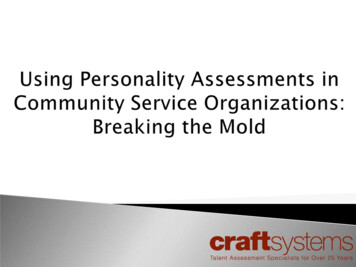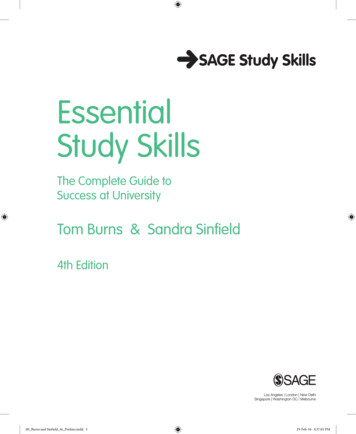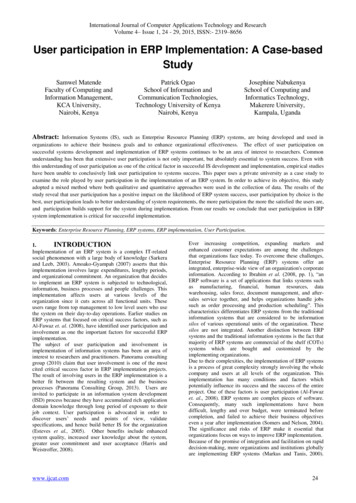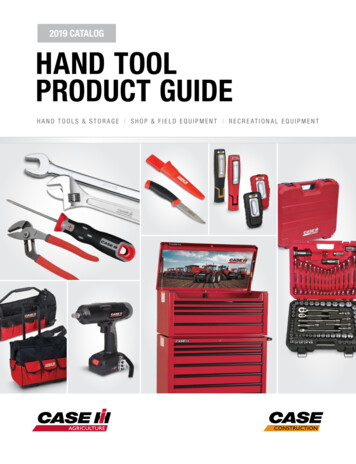
Transcription
Discuss a case study where an organizationapplied personality assessment to personnelselection.Discuss research into common personalitytraits among community service positions.Discuss the practical challenges andadvantages of using selection assessments innonprofit organizations.2
Over 1 million 501(c)(3) Public charities, Private foundations, and501(c) Nonprofit organizations in 2006¹.Common themes among case studies Small N setting Primarily competency driven People-focused positions Several key players involved Constrained resources Implemented the Craft Personality Questionnaire (CPQ) for help inreducing turnover and improving performance¹ Source NCSS (National Center for Charitable Statistics, www.ncssdataweb.urban.org)3
Craft Personality Questionnaire 75 items Measures “Basic Eight” traitsNumerous equivalent assessments available for selection purposesResources to consult: Association of Test Publishers SIOP APA Trade Associations (peers) Consultants4
‣Founded in 1973, VisionQuest provides safe way houses, camps,programs, and alternative schools in six states.‣Each location handles their own selection process and has their own HRpersonnel.‣The HR professional that contacted CraftSystems was a previous userof the personality assessment from another job.‣VisionQuest conducted a pilot program at one location to evaluate aselection model for their Child Care Worker and Child Care Directorpositions.“ there are many struggles when makingpersonnel decisions. Even though the CPQ saysthe candidate is a low or moderate fit we may stillhave to hire them because of our limitedcandidate pool. More time will have to be spentdeveloping the new hire.”Kate Gaston, VisionQuest6
‣Position Summary:“Provides youth with guidance, support, compassion, and structurethrough mentoring, role modeling, and the integration ofVisionQuest fabric to promote personal growth and development ”‣Developed a CPQ model using the following criteria‣Performance Rating‣Ratings on 9 job-related competencies‣Examples of job-related competencies include:‣Problem Sensitivity‣Professionalism‣Identifying Learning Strategies‣Analytical Thinking7
‣Position Summary:“Dynamic, assertive leader who oversees program norms andstandards in assigned living unit(s) to ensure safety and delivery ofcomprehensive program services for youth ”‣Developed a CPQ model using the following criteria‣Performance Rating‣Ratings on 8 job-related competencies‣Examples of job-related competencies include:‣Critical Thinking‣Management of Personnel Resources‣Multitasking‣Social Perceptiveness8
Very Low0% Low20%Mod Low Mod High40%50%Very HighHigh60%80%100%This trait measures the individual’s desire to rely on analysisor intuition/experience to make decisions. Intuitive Perceptive Visionary Analytical Calculating Logical9
Very Low0%Low20% Extraversion (MBTI) Intuition (MBTI) Feeling (MBTI) Perceiving (MBTI) Dominance (DiSC) Persuasive (OPQ32i) Variety Seeking (OPQ32i) Competitive (OPQ32i)Mod Low Mod High40%50%60%Very HighHigh80%100% Introversion (MBTI) Sensing (MBTI) Thinking (MBTI) Judging (MBTI) Conscientiousness (DiSC) Data Rationale (OPQ32i) Conventional (OPQ32i) Detail Conscious (OPQ32i) Perfectionism (16 PF)10
Very Low0%Low20% Client Relations Identifying LearningStrategies Creativity Social Perceptiveness MultitaskingMod Low Mod High40%50%60% Recruiting Technology ProfessionalismVery HighHigh80%100% Adherence to Policies Planning/Organizing Problem Analysis Conflict Resolution Persistence11
Very Low0%Low20%Mod Low Mod High40%50%60%Very HighHigh80%100%ModerateLowChild WorkerChild DirectorHigh12
Very Low0% Low20%Mod Low Mod High40%50%Very HighHigh60%80%100%This trait measures the individual’s desire to leave a goodimpression by exaggerating strengths and downplayingweaknesses. Reflective Fallible Humble Perfectionist Socially desirable Conscientious13
Very Low0%Low20% Independence (16PF) Abstractedness (16PF) Dominance (DiSC)Mod Low Mod High40%50%60%Very HighHigh80%100% Impression Management (16PF) Perfectionism (16PF) Self-control (16PF) Conscientiousness (Big 5) Dependability (Big 5) Steadiness (DiSC) Modest (OPQ32i)14
Very Low0%Low20% Creativity Customer Focus Judgment Receptivity to CoachingMod Low Mod High40%50%60%Very HighHigh80%100% Communicating Attention to Policies Social Perceptiveness Consistency Technology Organization/Planning Quality Management15
Very Low0%Low20%Mod Low Mod High40%50%60%Very HighHigh80%100%Child WorkerChild DirectorHighModerateLow16
Very Low0% Low20%Mod Low Mod High40%50%Very HighHigh60%80%100%This trait measures an individual’s need to nurture and carefor others. Emotionally controlled Task focused Cold demeanor Emotionally expressive Relationship focused Warm demeanor17
Very Low0%Low20%Mod Low Mod High40% Introversion (MBTI) Thinking (MBTI) Tough-Mindedness (16PF) Privateness (16PF) Controlling (OPQ32i) Emotionally Controlled (OPQ32i)50%60%Very HighHigh80%100% Extraversion (MBTI) Feeling (MBTI) Cooperation (Big 5) Sensitivity (16PF) Affiliative (OPQ32i) Trusting (OPQ32i)18
Very Low0%Low20% Consistency Organization/Planning Results Orientation Client TargetingMod Low Mod High40%50%60% Customer Focus Networking Supervising Teamwork MentoringVery HighHigh80%100% Adherence to Policies Collaboration Customer Relations Teamwork Therapy & Counseling Problem Sensitivity19
Very Low0%Low20%Mod Low Mod High40%50%60%Very HighHigh80%100%Child WorkerChild DirectorHighModerateLow20
Very Low0% Low20%Mod Low Mod High40%50%Very HighHigh60%80%100%This trait measures an individual’s trust of fellowemployees/managers and openness with others. Trusting Naïve Unquestioning Distrusting Inquisitive Synical21
Very Low0%Low20% Emotional Stability (16PF) Extraversion (16PF) Trusting (OPQ32i) Dependability (Big 5)Mod Low Mod High40%50%60%Very HighHigh80%100% Anxiety (16PF) Infrequency (16PF)22
Very Low0%Low20% Adherence to Policies Customer Contact Navigating Change Gathering Information Social PerceptivenessMod Low Mod High40%50%Very HighHigh60% Customer Focus Decision-making Influencing Receptivity to Coaching Supervising80%100% Networking Professionalism Influencing Recruiting Technology23
Very Low0%Low20%Mod Low Mod High40%50%Very HighHigh60%80%100%ModerateLowChild WorkerChild DirectorHigh24
Very Low0% Low20%Mod Low Mod High40%50%Very HighHigh60%80%100%This trait measures an individual’s physical, goal-orienteddrive and intensity level. Methodical Consistent Even-paced Results oriented Driven Impatient25
Very Low0%Low20% Stability (Big 5) Agreeableness (Big 5) Steadiness (DiSC) Modest (OPQ32i) Conventional (OPQ32i) Relaxed (OPQ32i)Mod Low Mod High40%50%60%Very HighHigh80%100% Tension (16PF) Dominance (DiSC) Achieving (OPQ32i) Persuasive (OPQ32i) Vigorous (OPQ32i) Competitive (OPQ32i)26
Very Low0%Low20% Collaboration Customer Service Mentoring Teamwork Technology Attention to DetailsMod Low Mod High40%50%60% Communication Customer Service Decision-making Mgmt Personnel Networking SupervisingVery HighHigh80%100% Initiative Social Perceptiveness Navigating Change Results Orientation Client Relations Multitasking27
Very Low0%Low20%Mod Low Mod High40%50%Very HighHigh60%80%100%Child WorkerChild DirectorHighModerateLow28
Very Low0% Low20%Mod Low Mod High40%50%Very HighHigh60%80%100%This trait measures an individual’s need for control andindependence. Conformist Peace maker Follower Controlling Independent Opinionated29
Very Low0%Low20% Feeling (MBTI) Self-control (16 PF) Steadiness (DiSC) Caring (OPQ32i) Trusting (OPQ32i) Conventional (OPQ32i)Mod Low Mod High40%50%60%Very HighHigh80%100% Thinking (MBTI) Independence (16PF) Dominance (16PF) Extraversion (Big 5) Leadership (Big 5) Dominance (DiSC) Decisive (OPQ32i) Controlling (OPQ32i)30
Very Low0%Low20% Collaboration Customer Service Learning & Growing Receptivity to Coaching TeamworkMod Low Mod High40%50%60% Communication Recruiting Teambuilding Flexibility Organizing/PlanningVery HighHigh80%100% Initiative Mentoring Negotiating Updating & UsingRelevant Knowledge31
Very Low0%Low20%Mod Low Mod High40%50%Very HighHigh60%80%100%Child WorkerChild DirectorHighModerateLow32
Very Low0% Low20%Mod Low Mod High40%50%Very HighHigh60%80%100%This trait measures an individual’s confidence to take thesocial initiative and be assertive when necessary. Unassertive Timid Shy Assertive Fearless Socially-interactive33
Very Low0%Low20% Modest (OPQ32i) Caring (OPQ32i) Worrying (OPQ32i) Sensing (MBTI) Judging (MBTI)Mod Low Mod High40%50%60%Very HighHigh80%100% Extraversion (Big 5) Openness (Big 5) Leadership (Big 5) Independence (16PF) Social Boldness (16PF) Dominance (16PF) Influence (DiSC) Outspoken (OPQ32i)34
Very Low0%Low20% Adherence to Policies Consistency Learning & Growing Receptivity to Coaching Flexibility Active ListeningMod Low Mod High40%50%60% Communication Judgment Mentoring Professionalism Active ListeningVery HighHigh80%100% Communication Social Perceptiveness Gathering Information Teambuilding Qualifying35
Very Low0%Low20%Mod Low Mod High40%50%60%Very HighHigh80%100%Child WorkerChild DirectorHighModerateLow36
Very Low0% Low20%Mod Low Mod High40%50%Very HighHigh60%80%100%This trait measures an individual’s social drive or need forpublic recognition. Internally satisfied Selective Socially controlled Externally motivated Competitive Award collector37
Very Low0%Low20% Introversion (MBTI) Conscientiousness (Big 5) Efficiency (Big 5) Steadiness (DiSC) Conscientiousness (DiSC) Modest (OPQ32i) Conventional (OPQ32i)Mod Low Mod High40%50%Very HighHigh60%80%100% Extraversion (MBTI) Extraversion (Big 5) Need for Recognition (Big 5) Influence (DiSC) Innovative (OPQ32i) Competitive (OPQ32i) Achieving (OPQ32i)38
Very Low0%Low20% Organizing/Planning Customer Service Receptivity to Coaching Role Matching Decision MakingMod Low Mod High40%50%60% Adherence to Policies Customer Service Supervising Mentoring TeamworkVery HighHigh80%100% Navigating Change Networking Presenting Handling Rejection Deductive Reasoning39
Very Low0%Low20%Mod Low Mod High40%50%60%Very HighHigh80%100%ModerateLowChild WorkerChild DirectorHigh40
Data qualityData quantityUnique jobsGeographic dispersion41
For more information on this case study orother studies, please contact:Dr. Amanda Evans aevans@craftsystems.comorDr. Doug Waldo drdwaldo@craftsytems.com(800)-228-5866
of the personality assessment from another job. ‣VisionQuest conducted a pilot program at one location to evaluate a . Impression Management (16PF) Perfectionism (16PF) Self-control (16PF) Conscientiousness (Big 5) Dependability (Big 5) Steadiness (DiSC)











